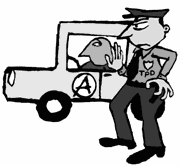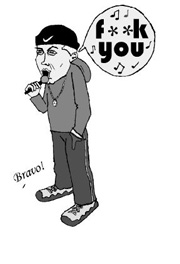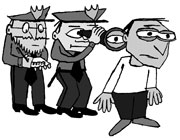A number of revelations have cast a disturbing shadow over both the steelworkers’ cancellation of the Kaiser aluminum plant demonstration in Tacoma last month and the hideous overreaction by the local cops to the canceled event.
For starters, Jon Youngdahl, the lead organizer of the steelworkers union, has apparently misled the media about the event’s cancellation. He emphatically denied, to me and to other media figures (Impolitics, “The Kaiser meltdown,” SW, 3/30) that fear of disruption, specifically by Eugene anarchists, was a major reason for the cancellation. In the last week, I’ve talked to a half-dozen people who vouch Youngdahl has stated at meetings in Tacoma and Portland that this was exactly the reason—and that media (and the public) would be intentionally misled so as not to air “dirty laundry.”
But it gets worse—much worse. Youngdahl’s fear was apparently fueled by two meetings with the Tacoma police, who had been contacted by the Eugene cops with the alarming news that the Eugene Police Department monitors the movements of its city’s anarchists and that—gasp—they didn’t know where some of them were.
Ergo, they must be getting ready to, with a well-placed homemade explosive, blow up the Port of Tacoma, as claimed in the Tacoma News-Tribune on April 5. As a result, all 350 Tacoma police officers, plus support from the Pierce County Sheriff’s Department and other area agencies, turned out for a protest that was canceled, and spent their bored hours harassing the few union and enviro activists who showed up to offer picket-line support despite the cancellation.
Tacoma Police Department spokesperson Jim Mattheis declined to give further information on why the police were so alarmed over the anarchist threat, stating only that it was based on intelligence. (An argument can be made about that. . . .) According to Mattheis, in the two meetings with the steelworkers, “I think that some of that information was shared with them, but I’m not positive.” Bear in mind that the police and Youngdahl’s fear alike are based on a group of activists that 1) threw rocks at a Eugene demonstration last June 18, and 2) used hammers and boots to smash windows in Seattle on November 30. That’s it. No record of the sort of terrorist threat being bandied about exists. Given that the Kaiser plant is in an abandoned industrial part of town, and that there’s little access to the plant or windows to break, it’s hard to imagine what damage consistent with their past record could be done. Or what the fuss was about. A well-organized gang did send dozens to area hospitals in Seattle with their incendiary devices last fall, but that was the Seattle Police Department.
A media feeding frenzy
Media was let into the feeding frenzy with a wholly fictitious Tacoma police report on Saturday, March 25, that a “known anarchist from the Eugene area” had been arrested—no charge was specified—with two loaded rifles and a loaded shotgun in the back seat (Seattle P-I, 3/27). The occasion, as it turns out, was a traffic stop by the Washington State Patrol, one of many in the area. Protesters assert the stops were harassment of would-be demonstrators. It’s not illegal to be an anarchist (how is someone a “known anarchist,” anyway? Who is that? Noam Chomsky? Murray Bookchin? John Zerzan himself?) or to carry unconcealed weapons. No arrest was made. It was, according to a WSP spokesperson, “a nonincident.” I asked the WSP’s Dan Eikum how troopers could have known that a traffic-stop motorist was an anarchist? “I don’t know.” How could the trooper have known that the person was associated with the Kaiser demo? “I don’t know.”
The Tacoma News Tribune also reported a total of 21 arrests on Saturday and Sunday, all for traffic violations. But Tacoma police’s Mattheis concedes the 21 arrests were not necessarily connected with picketing at the Kaiser plant. Could it have simply been a result of the heavy police presence in the area? All told, picketers themselves knew of only one arrest, a now-famous incident involving Zan the Rad Dyke Plumber.
We have, then, alarmist (and fictitious) stories planted in the media and used to help justify an overwhelming police presence, harassment of legal demonstrators, and hundreds of thousands of Tacoma tax dollars in overtime. That same alarmist agenda, banking on the public’s fear of “violent anarchists,” was used to encourage the steelworkers’ union to cancel the demonstration. Mattheis says the police did not ask the steelworkers to cancel—but they didn’t need to. Youngdahl’s fear of an uncontrollable event was sufficient.
I’ve also heard from several people who did show up at Kaiser that the alliance destroyed by the steelworkers’ cancellation was developed, stronger than ever, at the level of the outnumbered rank and file demonstrators who were pushed around by police. Indeed, many of the same folks came together on short notice to organize the stirring victory last week at Terminal 18, in which longshoremen refused to unload some Department of Defense toxic waste that had previously been refused by the government of Canada.
So the dreams of labor-environmentalist alliances aren’t dead. But no matter how much camaraderie was developed among the 50 or so activists harassed by cops in Tacoma’s Tideflats on March 25, a serious problem remains. So long as weeks of organizing by labor and community activists can be undone by the simple suggestion that “undesirables” might attend, there will be no alliance between labor leaders and grassroots community groups. Those same “undesirables” can be used to plant fear of activism and unions in the public’s perception. It hardly matters that the threat posed by the anarchists from Eugene is more myth than reality. Kaiser Aluminum’s owner, the junk bond and S&L robber baron Charles Hurwitz, must be laughing his ass off.







